Seralini Affair: Controversy in Food and Chemical Toxicology Review
VerifiedAdded on 2023/06/15
|8
|2482
|302
Essay
AI Summary
This essay delves into the Seralini affair, a significant controversy in food and chemical toxicology, focusing on the challenges of dealing with genetically modified foods and the implications of chemical modifications on crop development. It examines the controversial publication in Food and Chemical Toxicology, which reported increased tumor development in rats fed genetically modified corn and the herbicide Roundup, sparking widespread criticism and ethical debates. The essay discusses the scientific and ethical issues surrounding the study, including concerns about the research methodology, data interpretation, and public communication. Furthermore, it explores the retraction and subsequent republication of the study, highlighting the complexities of scientific validation and the impact of public perception on scientific findings. The analysis considers arguments from various perspectives, including those of scientists, regulatory authorities, and the public, to provide a comprehensive understanding of the controversy and its broader implications for food safety and public health. Desklib offers more solved assignments and study tools for students.

Individual Assessment
Paraphrase This Document
Need a fresh take? Get an instant paraphrase of this document with our AI Paraphraser

Table of Contents
INTRODUCTION...........................................................................................................................3
MAIN BODY...................................................................................................................................3
CONCLUSION................................................................................................................................7
REFERENCES................................................................................................................................8
INTRODUCTION...........................................................................................................................3
MAIN BODY...................................................................................................................................3
CONCLUSION................................................................................................................................7
REFERENCES................................................................................................................................8
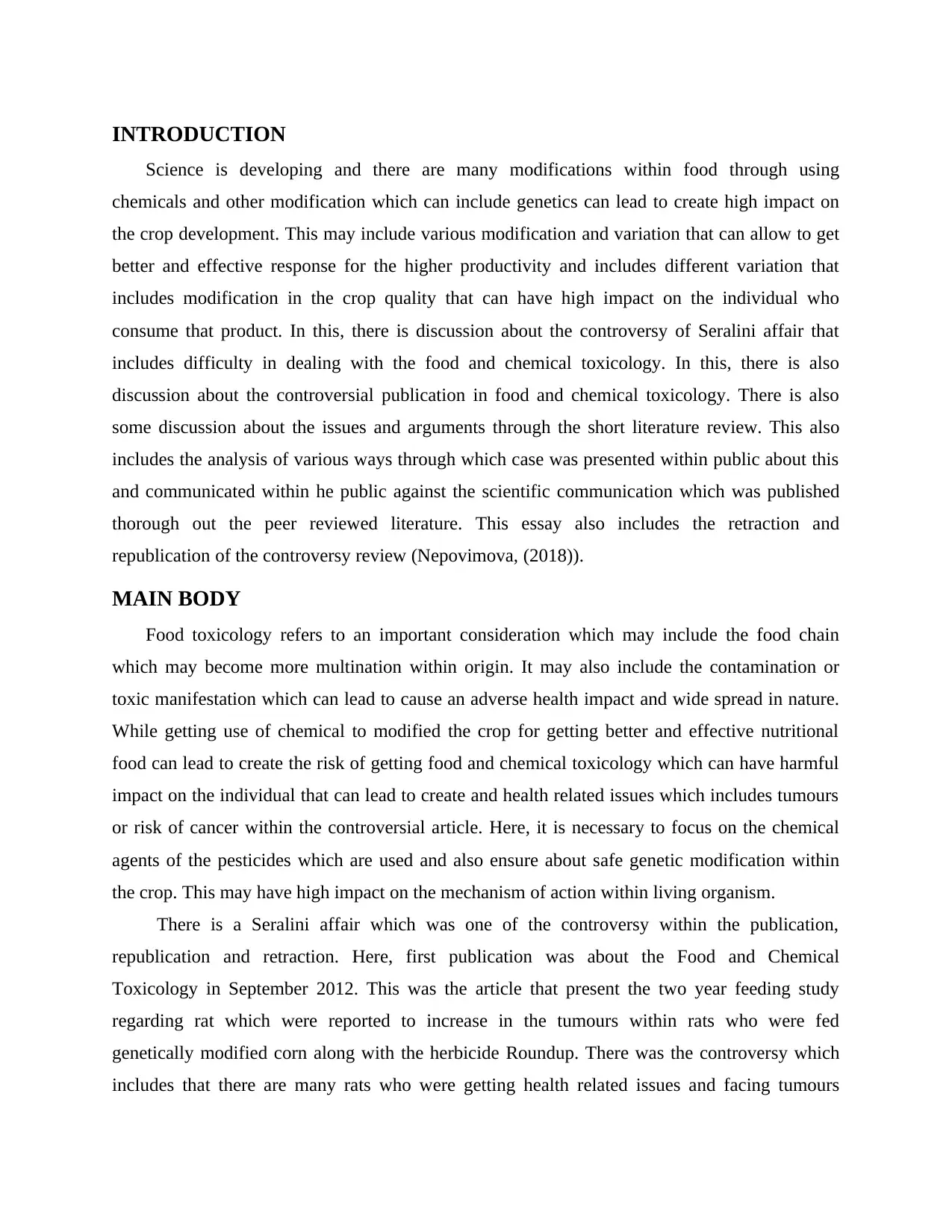
INTRODUCTION
Science is developing and there are many modifications within food through using
chemicals and other modification which can include genetics can lead to create high impact on
the crop development. This may include various modification and variation that can allow to get
better and effective response for the higher productivity and includes different variation that
includes modification in the crop quality that can have high impact on the individual who
consume that product. In this, there is discussion about the controversy of Seralini affair that
includes difficulty in dealing with the food and chemical toxicology. In this, there is also
discussion about the controversial publication in food and chemical toxicology. There is also
some discussion about the issues and arguments through the short literature review. This also
includes the analysis of various ways through which case was presented within public about this
and communicated within he public against the scientific communication which was published
thorough out the peer reviewed literature. This essay also includes the retraction and
republication of the controversy review (Nepovimova, (2018)).
MAIN BODY
Food toxicology refers to an important consideration which may include the food chain
which may become more multination within origin. It may also include the contamination or
toxic manifestation which can lead to cause an adverse health impact and wide spread in nature.
While getting use of chemical to modified the crop for getting better and effective nutritional
food can lead to create the risk of getting food and chemical toxicology which can have harmful
impact on the individual that can lead to create and health related issues which includes tumours
or risk of cancer within the controversial article. Here, it is necessary to focus on the chemical
agents of the pesticides which are used and also ensure about safe genetic modification within
the crop. This may have high impact on the mechanism of action within living organism.
There is a Seralini affair which was one of the controversy within the publication,
republication and retraction. Here, first publication was about the Food and Chemical
Toxicology in September 2012. This was the article that present the two year feeding study
regarding rat which were reported to increase in the tumours within rats who were fed
genetically modified corn along with the herbicide Roundup. There was the controversy which
includes that there are many rats who were getting health related issues and facing tumours
Science is developing and there are many modifications within food through using
chemicals and other modification which can include genetics can lead to create high impact on
the crop development. This may include various modification and variation that can allow to get
better and effective response for the higher productivity and includes different variation that
includes modification in the crop quality that can have high impact on the individual who
consume that product. In this, there is discussion about the controversy of Seralini affair that
includes difficulty in dealing with the food and chemical toxicology. In this, there is also
discussion about the controversial publication in food and chemical toxicology. There is also
some discussion about the issues and arguments through the short literature review. This also
includes the analysis of various ways through which case was presented within public about this
and communicated within he public against the scientific communication which was published
thorough out the peer reviewed literature. This essay also includes the retraction and
republication of the controversy review (Nepovimova, (2018)).
MAIN BODY
Food toxicology refers to an important consideration which may include the food chain
which may become more multination within origin. It may also include the contamination or
toxic manifestation which can lead to cause an adverse health impact and wide spread in nature.
While getting use of chemical to modified the crop for getting better and effective nutritional
food can lead to create the risk of getting food and chemical toxicology which can have harmful
impact on the individual that can lead to create and health related issues which includes tumours
or risk of cancer within the controversial article. Here, it is necessary to focus on the chemical
agents of the pesticides which are used and also ensure about safe genetic modification within
the crop. This may have high impact on the mechanism of action within living organism.
There is a Seralini affair which was one of the controversy within the publication,
republication and retraction. Here, first publication was about the Food and Chemical
Toxicology in September 2012. This was the article that present the two year feeding study
regarding rat which were reported to increase in the tumours within rats who were fed
genetically modified corn along with the herbicide Roundup. There was the controversy which
includes that there are many rats who were getting health related issues and facing tumours
⊘ This is a preview!⊘
Do you want full access?
Subscribe today to unlock all pages.

Trusted by 1+ million students worldwide
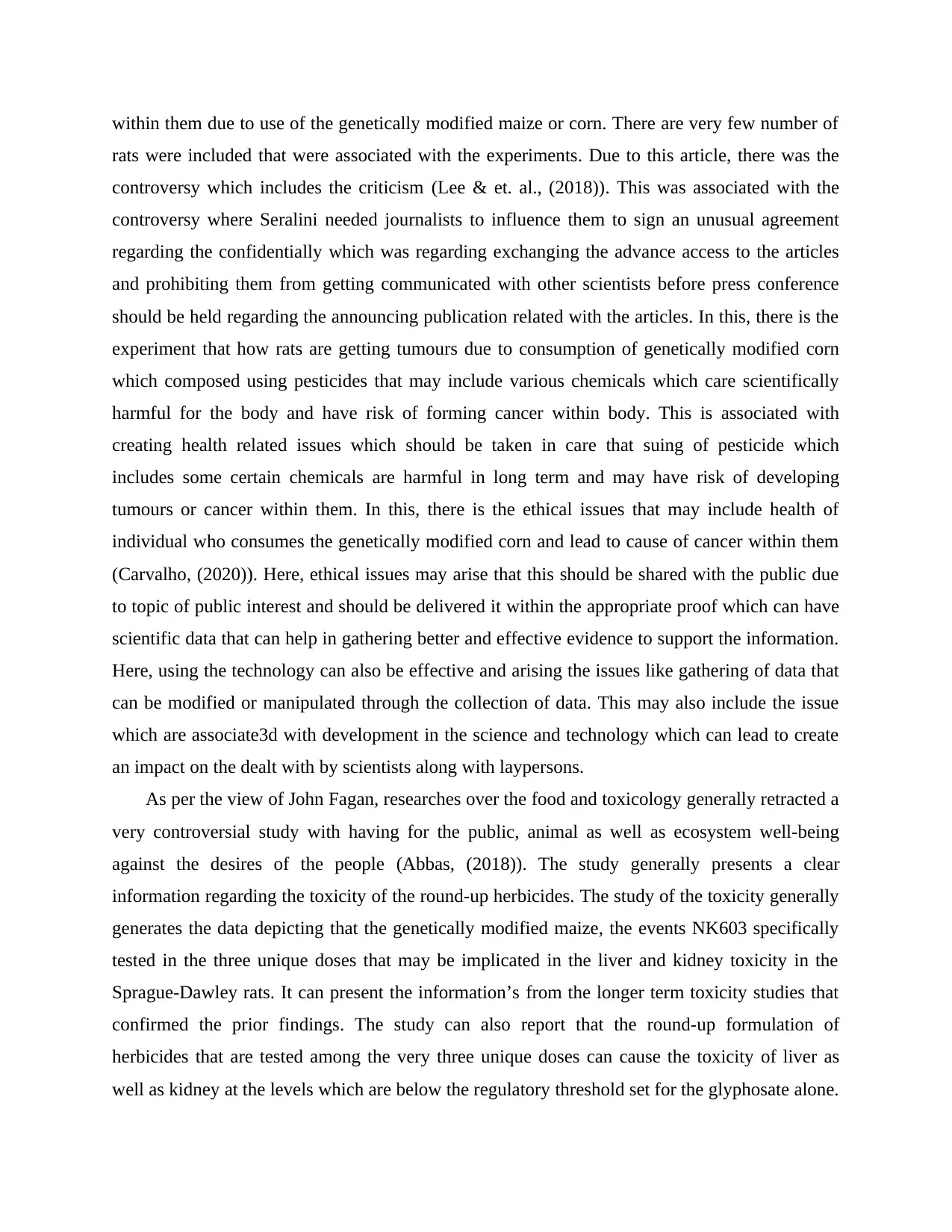
within them due to use of the genetically modified maize or corn. There are very few number of
rats were included that were associated with the experiments. Due to this article, there was the
controversy which includes the criticism (Lee & et. al., (2018)). This was associated with the
controversy where Seralini needed journalists to influence them to sign an unusual agreement
regarding the confidentially which was regarding exchanging the advance access to the articles
and prohibiting them from getting communicated with other scientists before press conference
should be held regarding the announcing publication related with the articles. In this, there is the
experiment that how rats are getting tumours due to consumption of genetically modified corn
which composed using pesticides that may include various chemicals which care scientifically
harmful for the body and have risk of forming cancer within body. This is associated with
creating health related issues which should be taken in care that suing of pesticide which
includes some certain chemicals are harmful in long term and may have risk of developing
tumours or cancer within them. In this, there is the ethical issues that may include health of
individual who consumes the genetically modified corn and lead to cause of cancer within them
(Carvalho, (2020)). Here, ethical issues may arise that this should be shared with the public due
to topic of public interest and should be delivered it within the appropriate proof which can have
scientific data that can help in gathering better and effective evidence to support the information.
Here, using the technology can also be effective and arising the issues like gathering of data that
can be modified or manipulated through the collection of data. This may also include the issue
which are associate3d with development in the science and technology which can lead to create
an impact on the dealt with by scientists along with laypersons.
As per the view of John Fagan, researches over the food and toxicology generally retracted a
very controversial study with having for the public, animal as well as ecosystem well-being
against the desires of the people (Abbas, (2018)). The study generally presents a clear
information regarding the toxicity of the round-up herbicides. The study of the toxicity generally
generates the data depicting that the genetically modified maize, the events NK603 specifically
tested in the three unique doses that may be implicated in the liver and kidney toxicity in the
Sprague-Dawley rats. It can present the information’s from the longer term toxicity studies that
confirmed the prior findings. The study can also report that the round-up formulation of
herbicides that are tested among the very three unique doses can cause the toxicity of liver as
well as kidney at the levels which are below the regulatory threshold set for the glyphosate alone.
rats were included that were associated with the experiments. Due to this article, there was the
controversy which includes the criticism (Lee & et. al., (2018)). This was associated with the
controversy where Seralini needed journalists to influence them to sign an unusual agreement
regarding the confidentially which was regarding exchanging the advance access to the articles
and prohibiting them from getting communicated with other scientists before press conference
should be held regarding the announcing publication related with the articles. In this, there is the
experiment that how rats are getting tumours due to consumption of genetically modified corn
which composed using pesticides that may include various chemicals which care scientifically
harmful for the body and have risk of forming cancer within body. This is associated with
creating health related issues which should be taken in care that suing of pesticide which
includes some certain chemicals are harmful in long term and may have risk of developing
tumours or cancer within them. In this, there is the ethical issues that may include health of
individual who consumes the genetically modified corn and lead to cause of cancer within them
(Carvalho, (2020)). Here, ethical issues may arise that this should be shared with the public due
to topic of public interest and should be delivered it within the appropriate proof which can have
scientific data that can help in gathering better and effective evidence to support the information.
Here, using the technology can also be effective and arising the issues like gathering of data that
can be modified or manipulated through the collection of data. This may also include the issue
which are associate3d with development in the science and technology which can lead to create
an impact on the dealt with by scientists along with laypersons.
As per the view of John Fagan, researches over the food and toxicology generally retracted a
very controversial study with having for the public, animal as well as ecosystem well-being
against the desires of the people (Abbas, (2018)). The study generally presents a clear
information regarding the toxicity of the round-up herbicides. The study of the toxicity generally
generates the data depicting that the genetically modified maize, the events NK603 specifically
tested in the three unique doses that may be implicated in the liver and kidney toxicity in the
Sprague-Dawley rats. It can present the information’s from the longer term toxicity studies that
confirmed the prior findings. The study can also report that the round-up formulation of
herbicides that are tested among the very three unique doses can cause the toxicity of liver as
well as kidney at the levels which are below the regulatory threshold set for the glyphosate alone.
Paraphrase This Document
Need a fresh take? Get an instant paraphrase of this document with our AI Paraphraser
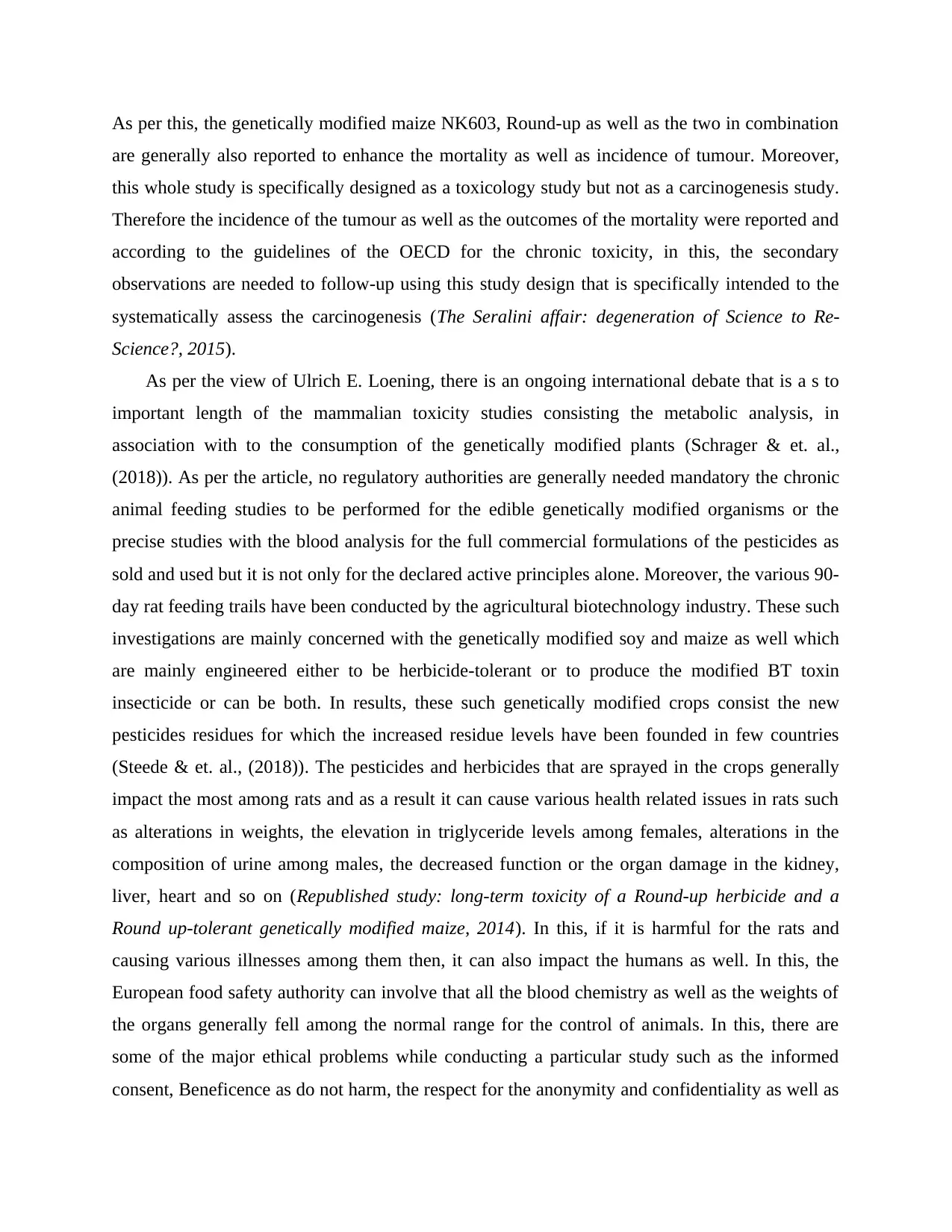
As per this, the genetically modified maize NK603, Round-up as well as the two in combination
are generally also reported to enhance the mortality as well as incidence of tumour. Moreover,
this whole study is specifically designed as a toxicology study but not as a carcinogenesis study.
Therefore the incidence of the tumour as well as the outcomes of the mortality were reported and
according to the guidelines of the OECD for the chronic toxicity, in this, the secondary
observations are needed to follow-up using this study design that is specifically intended to the
systematically assess the carcinogenesis (The Seralini affair: degeneration of Science to Re-
Science?, 2015).
As per the view of Ulrich E. Loening, there is an ongoing international debate that is a s to
important length of the mammalian toxicity studies consisting the metabolic analysis, in
association with to the consumption of the genetically modified plants (Schrager & et. al.,
(2018)). As per the article, no regulatory authorities are generally needed mandatory the chronic
animal feeding studies to be performed for the edible genetically modified organisms or the
precise studies with the blood analysis for the full commercial formulations of the pesticides as
sold and used but it is not only for the declared active principles alone. Moreover, the various 90-
day rat feeding trails have been conducted by the agricultural biotechnology industry. These such
investigations are mainly concerned with the genetically modified soy and maize as well which
are mainly engineered either to be herbicide-tolerant or to produce the modified BT toxin
insecticide or can be both. In results, these such genetically modified crops consist the new
pesticides residues for which the increased residue levels have been founded in few countries
(Steede & et. al., (2018)). The pesticides and herbicides that are sprayed in the crops generally
impact the most among rats and as a result it can cause various health related issues in rats such
as alterations in weights, the elevation in triglyceride levels among females, alterations in the
composition of urine among males, the decreased function or the organ damage in the kidney,
liver, heart and so on (Republished study: long-term toxicity of a Round-up herbicide and a
Round up-tolerant genetically modified maize, 2014). In this, if it is harmful for the rats and
causing various illnesses among them then, it can also impact the humans as well. In this, the
European food safety authority can involve that all the blood chemistry as well as the weights of
the organs generally fell among the normal range for the control of animals. In this, there are
some of the major ethical problems while conducting a particular study such as the informed
consent, Beneficence as do not harm, the respect for the anonymity and confidentiality as well as
are generally also reported to enhance the mortality as well as incidence of tumour. Moreover,
this whole study is specifically designed as a toxicology study but not as a carcinogenesis study.
Therefore the incidence of the tumour as well as the outcomes of the mortality were reported and
according to the guidelines of the OECD for the chronic toxicity, in this, the secondary
observations are needed to follow-up using this study design that is specifically intended to the
systematically assess the carcinogenesis (The Seralini affair: degeneration of Science to Re-
Science?, 2015).
As per the view of Ulrich E. Loening, there is an ongoing international debate that is a s to
important length of the mammalian toxicity studies consisting the metabolic analysis, in
association with to the consumption of the genetically modified plants (Schrager & et. al.,
(2018)). As per the article, no regulatory authorities are generally needed mandatory the chronic
animal feeding studies to be performed for the edible genetically modified organisms or the
precise studies with the blood analysis for the full commercial formulations of the pesticides as
sold and used but it is not only for the declared active principles alone. Moreover, the various 90-
day rat feeding trails have been conducted by the agricultural biotechnology industry. These such
investigations are mainly concerned with the genetically modified soy and maize as well which
are mainly engineered either to be herbicide-tolerant or to produce the modified BT toxin
insecticide or can be both. In results, these such genetically modified crops consist the new
pesticides residues for which the increased residue levels have been founded in few countries
(Steede & et. al., (2018)). The pesticides and herbicides that are sprayed in the crops generally
impact the most among rats and as a result it can cause various health related issues in rats such
as alterations in weights, the elevation in triglyceride levels among females, alterations in the
composition of urine among males, the decreased function or the organ damage in the kidney,
liver, heart and so on (Republished study: long-term toxicity of a Round-up herbicide and a
Round up-tolerant genetically modified maize, 2014). In this, if it is harmful for the rats and
causing various illnesses among them then, it can also impact the humans as well. In this, the
European food safety authority can involve that all the blood chemistry as well as the weights of
the organs generally fell among the normal range for the control of animals. In this, there are
some of the major ethical problems while conducting a particular study such as the informed
consent, Beneficence as do not harm, the respect for the anonymity and confidentiality as well as
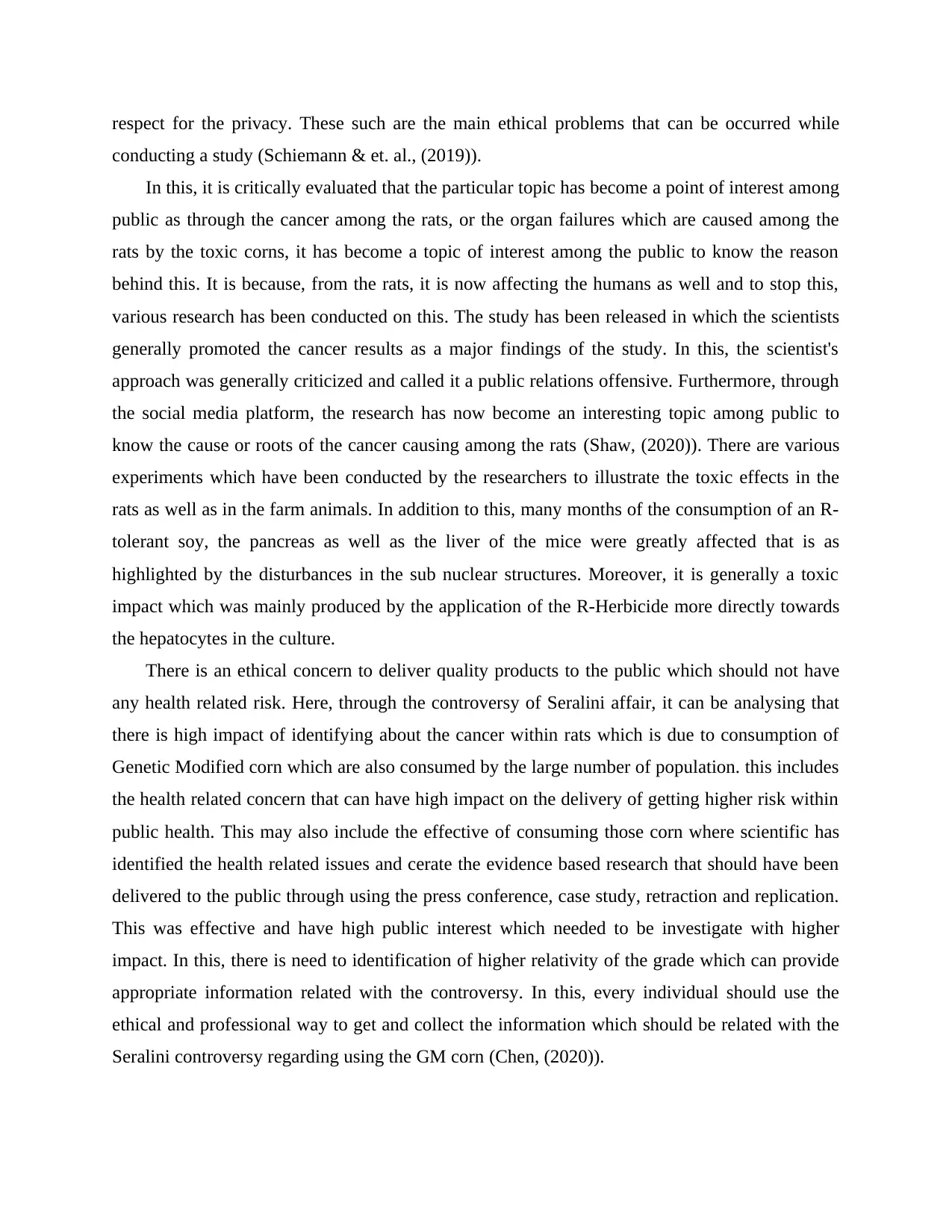
respect for the privacy. These such are the main ethical problems that can be occurred while
conducting a study (Schiemann & et. al., (2019)).
In this, it is critically evaluated that the particular topic has become a point of interest among
public as through the cancer among the rats, or the organ failures which are caused among the
rats by the toxic corns, it has become a topic of interest among the public to know the reason
behind this. It is because, from the rats, it is now affecting the humans as well and to stop this,
various research has been conducted on this. The study has been released in which the scientists
generally promoted the cancer results as a major findings of the study. In this, the scientist's
approach was generally criticized and called it a public relations offensive. Furthermore, through
the social media platform, the research has now become an interesting topic among public to
know the cause or roots of the cancer causing among the rats (Shaw, (2020)). There are various
experiments which have been conducted by the researchers to illustrate the toxic effects in the
rats as well as in the farm animals. In addition to this, many months of the consumption of an R-
tolerant soy, the pancreas as well as the liver of the mice were greatly affected that is as
highlighted by the disturbances in the sub nuclear structures. Moreover, it is generally a toxic
impact which was mainly produced by the application of the R-Herbicide more directly towards
the hepatocytes in the culture.
There is an ethical concern to deliver quality products to the public which should not have
any health related risk. Here, through the controversy of Seralini affair, it can be analysing that
there is high impact of identifying about the cancer within rats which is due to consumption of
Genetic Modified corn which are also consumed by the large number of population. this includes
the health related concern that can have high impact on the delivery of getting higher risk within
public health. This may also include the effective of consuming those corn where scientific has
identified the health related issues and cerate the evidence based research that should have been
delivered to the public through using the press conference, case study, retraction and replication.
This was effective and have high public interest which needed to be investigate with higher
impact. In this, there is need to identification of higher relativity of the grade which can provide
appropriate information related with the controversy. In this, every individual should use the
ethical and professional way to get and collect the information which should be related with the
Seralini controversy regarding using the GM corn (Chen, (2020)).
conducting a study (Schiemann & et. al., (2019)).
In this, it is critically evaluated that the particular topic has become a point of interest among
public as through the cancer among the rats, or the organ failures which are caused among the
rats by the toxic corns, it has become a topic of interest among the public to know the reason
behind this. It is because, from the rats, it is now affecting the humans as well and to stop this,
various research has been conducted on this. The study has been released in which the scientists
generally promoted the cancer results as a major findings of the study. In this, the scientist's
approach was generally criticized and called it a public relations offensive. Furthermore, through
the social media platform, the research has now become an interesting topic among public to
know the cause or roots of the cancer causing among the rats (Shaw, (2020)). There are various
experiments which have been conducted by the researchers to illustrate the toxic effects in the
rats as well as in the farm animals. In addition to this, many months of the consumption of an R-
tolerant soy, the pancreas as well as the liver of the mice were greatly affected that is as
highlighted by the disturbances in the sub nuclear structures. Moreover, it is generally a toxic
impact which was mainly produced by the application of the R-Herbicide more directly towards
the hepatocytes in the culture.
There is an ethical concern to deliver quality products to the public which should not have
any health related risk. Here, through the controversy of Seralini affair, it can be analysing that
there is high impact of identifying about the cancer within rats which is due to consumption of
Genetic Modified corn which are also consumed by the large number of population. this includes
the health related concern that can have high impact on the delivery of getting higher risk within
public health. This may also include the effective of consuming those corn where scientific has
identified the health related issues and cerate the evidence based research that should have been
delivered to the public through using the press conference, case study, retraction and replication.
This was effective and have high public interest which needed to be investigate with higher
impact. In this, there is need to identification of higher relativity of the grade which can provide
appropriate information related with the controversy. In this, every individual should use the
ethical and professional way to get and collect the information which should be related with the
Seralini controversy regarding using the GM corn (Chen, (2020)).
⊘ This is a preview!⊘
Do you want full access?
Subscribe today to unlock all pages.

Trusted by 1+ million students worldwide
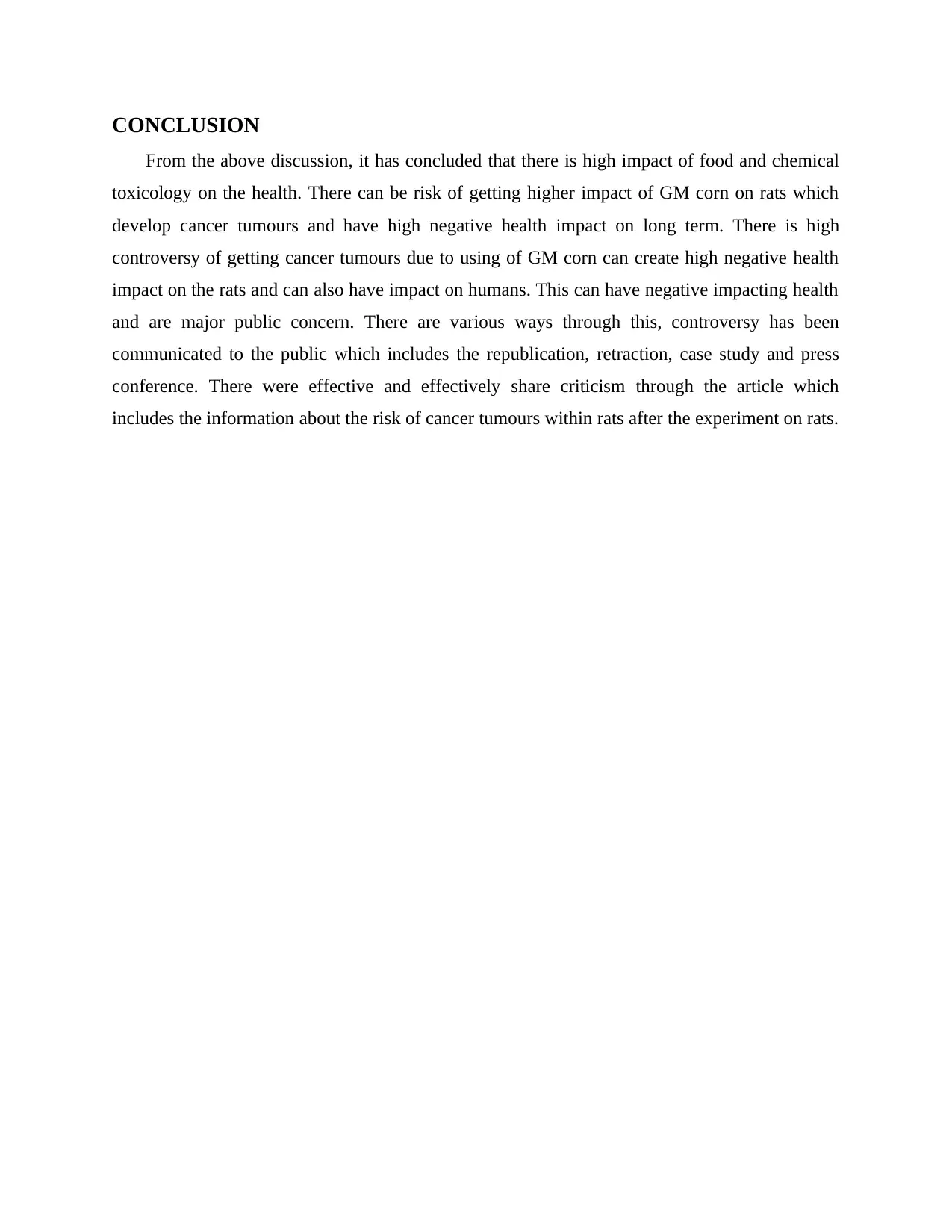
CONCLUSION
From the above discussion, it has concluded that there is high impact of food and chemical
toxicology on the health. There can be risk of getting higher impact of GM corn on rats which
develop cancer tumours and have high negative health impact on long term. There is high
controversy of getting cancer tumours due to using of GM corn can create high negative health
impact on the rats and can also have impact on humans. This can have negative impacting health
and are major public concern. There are various ways through this, controversy has been
communicated to the public which includes the republication, retraction, case study and press
conference. There were effective and effectively share criticism through the article which
includes the information about the risk of cancer tumours within rats after the experiment on rats.
From the above discussion, it has concluded that there is high impact of food and chemical
toxicology on the health. There can be risk of getting higher impact of GM corn on rats which
develop cancer tumours and have high negative health impact on long term. There is high
controversy of getting cancer tumours due to using of GM corn can create high negative health
impact on the rats and can also have impact on humans. This can have negative impacting health
and are major public concern. There are various ways through this, controversy has been
communicated to the public which includes the republication, retraction, case study and press
conference. There were effective and effectively share criticism through the article which
includes the information about the risk of cancer tumours within rats after the experiment on rats.
Paraphrase This Document
Need a fresh take? Get an instant paraphrase of this document with our AI Paraphraser
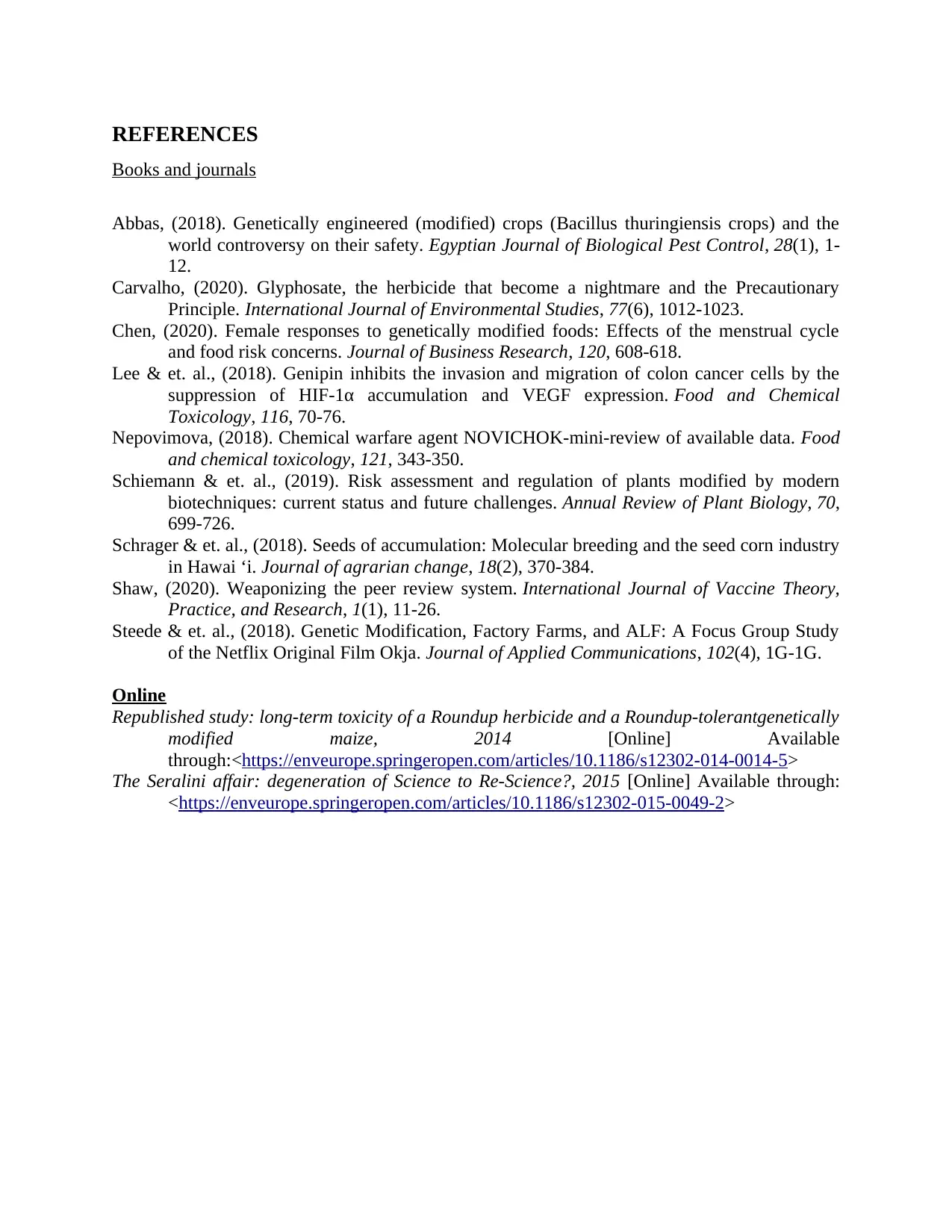
REFERENCES
Books and journals
Abbas, (2018). Genetically engineered (modified) crops (Bacillus thuringiensis crops) and the
world controversy on their safety. Egyptian Journal of Biological Pest Control, 28(1), 1-
12.
Carvalho, (2020). Glyphosate, the herbicide that become a nightmare and the Precautionary
Principle. International Journal of Environmental Studies, 77(6), 1012-1023.
Chen, (2020). Female responses to genetically modified foods: Effects of the menstrual cycle
and food risk concerns. Journal of Business Research, 120, 608-618.
Lee & et. al., (2018). Genipin inhibits the invasion and migration of colon cancer cells by the
suppression of HIF-1α accumulation and VEGF expression. Food and Chemical
Toxicology, 116, 70-76.
Nepovimova, (2018). Chemical warfare agent NOVICHOK-mini-review of available data. Food
and chemical toxicology, 121, 343-350.
Schiemann & et. al., (2019). Risk assessment and regulation of plants modified by modern
biotechniques: current status and future challenges. Annual Review of Plant Biology, 70,
699-726.
Schrager & et. al., (2018). Seeds of accumulation: Molecular breeding and the seed corn industry
in Hawai ‘i. Journal of agrarian change, 18(2), 370-384.
Shaw, (2020). Weaponizing the peer review system. International Journal of Vaccine Theory,
Practice, and Research, 1(1), 11-26.
Steede & et. al., (2018). Genetic Modification, Factory Farms, and ALF: A Focus Group Study
of the Netflix Original Film Okja. Journal of Applied Communications, 102(4), 1G-1G.
Online
Republished study: long-term toxicity of a Roundup herbicide and a Roundup-tolerantgenetically
modified maize, 2014 [Online] Available
through:<https://enveurope.springeropen.com/articles/10.1186/s12302-014-0014-5>
The Seralini affair: degeneration of Science to Re-Science?, 2015 [Online] Available through:
<https://enveurope.springeropen.com/articles/10.1186/s12302-015-0049-2>
Books and journals
Abbas, (2018). Genetically engineered (modified) crops (Bacillus thuringiensis crops) and the
world controversy on their safety. Egyptian Journal of Biological Pest Control, 28(1), 1-
12.
Carvalho, (2020). Glyphosate, the herbicide that become a nightmare and the Precautionary
Principle. International Journal of Environmental Studies, 77(6), 1012-1023.
Chen, (2020). Female responses to genetically modified foods: Effects of the menstrual cycle
and food risk concerns. Journal of Business Research, 120, 608-618.
Lee & et. al., (2018). Genipin inhibits the invasion and migration of colon cancer cells by the
suppression of HIF-1α accumulation and VEGF expression. Food and Chemical
Toxicology, 116, 70-76.
Nepovimova, (2018). Chemical warfare agent NOVICHOK-mini-review of available data. Food
and chemical toxicology, 121, 343-350.
Schiemann & et. al., (2019). Risk assessment and regulation of plants modified by modern
biotechniques: current status and future challenges. Annual Review of Plant Biology, 70,
699-726.
Schrager & et. al., (2018). Seeds of accumulation: Molecular breeding and the seed corn industry
in Hawai ‘i. Journal of agrarian change, 18(2), 370-384.
Shaw, (2020). Weaponizing the peer review system. International Journal of Vaccine Theory,
Practice, and Research, 1(1), 11-26.
Steede & et. al., (2018). Genetic Modification, Factory Farms, and ALF: A Focus Group Study
of the Netflix Original Film Okja. Journal of Applied Communications, 102(4), 1G-1G.
Online
Republished study: long-term toxicity of a Roundup herbicide and a Roundup-tolerantgenetically
modified maize, 2014 [Online] Available
through:<https://enveurope.springeropen.com/articles/10.1186/s12302-014-0014-5>
The Seralini affair: degeneration of Science to Re-Science?, 2015 [Online] Available through:
<https://enveurope.springeropen.com/articles/10.1186/s12302-015-0049-2>
1 out of 8
Related Documents
Your All-in-One AI-Powered Toolkit for Academic Success.
+13062052269
info@desklib.com
Available 24*7 on WhatsApp / Email
![[object Object]](/_next/static/media/star-bottom.7253800d.svg)
Unlock your academic potential
Copyright © 2020–2025 A2Z Services. All Rights Reserved. Developed and managed by ZUCOL.





